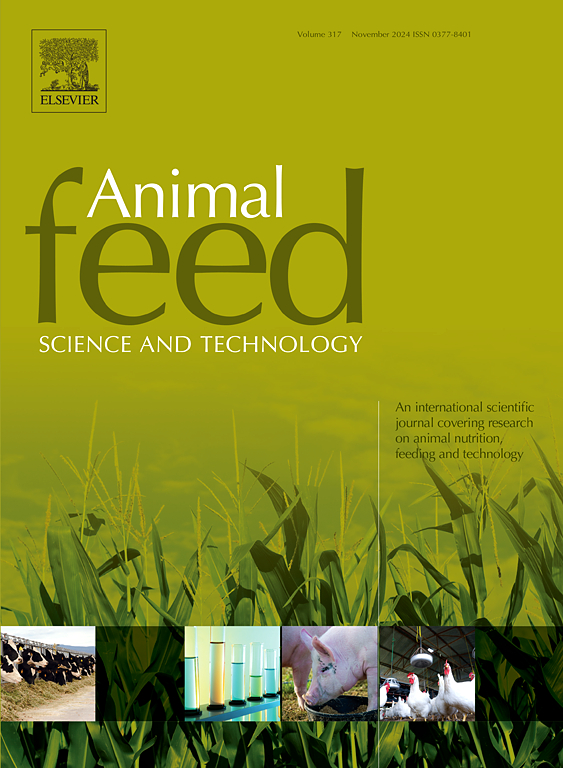Effects of dietary vitamin C supplementation on growth performance, antioxidant status, and growth hormone and insulin-like growth factor 1 levels in juvenile walleye pollock (Gadus chalcogrammus)
IF 2.5
2区 农林科学
Q1 AGRICULTURE, DAIRY & ANIMAL SCIENCE
引用次数: 0
Abstract
Vitamin C (VC) is an essential micronutrient that plays a critical role in growth performance and antioxidant status of fish. However, no study has examined VC levels in the juvenile walleye pollock (Gadus chalcogrammus) diet. Thus, six isoproteic and isolipidic diets containing 3.32, 22.08, 63.67, 101.72, 145.88, and 202.81 mg kg−1 VC were prepared and 8-week feeding trial was conducted. The fish fed the 145.88 mg kg−1 VC diet exhibited the greatest growth (final weight, weight gain, and specific growth rate) and feed utilization (feed efficiency and protein efficiency ratio. Fish fed the diet supplemented with 145.88 mg kg−1 Vc had significantly higher crude whole-body protein content than those fed the 3.32 and 22.08 mg kg−1 Vc diets. The whole-body crude lipid content of fish fed the 145.88 mg kg−1 Vc diet was significantly higher than that of fish fed diets containing 3.32–101.72 mg kg−1. However, the dietary Vc content did not affect the whole-body moisture, ash contents and plasma hematological parameters of juvenile walleye pollock. Plasma superoxide dismutase activity was significantly lowered in fish fed the 202.81 mg kg−1 VC diet. Fish fed the 145.88 and 202.81 mg kg−1 VC diets displayed higher plasma growth hormone and insulin-like growth factor-1 levels. In conclusion, the growth performance and superoxide dismutase activity of juvenile walleye pollock can be enhanced via dietary VC inclusion at levels of 145.88–202.81 mg kg−1. Based on broken-line regression analysis of weight gain, the optimal dietary Vc requirement was estimated to be 168.28 mg kg⁻¹. These findings provide species-specific guidance for Vc inclusion in aquafeeds to support efficient and sustainable aquaculture of walleye pollock.
饲粮中添加维生素C对狭鳕幼鱼生长性能、抗氧化状态及生长激素和胰岛素样生长因子1水平的影响
维生素 C(VC)是一种必需的微量营养元素,对鱼类的生长性能和抗氧化状态起着至关重要的作用。然而,还没有研究对幼年马眼狭鳕(Gadus chalcogrammus)日粮中的维生素 C 含量进行过检测。因此,我们制备了六种含有 3.32、22.08、63.67、101.72、145.88 和 202.81 mg kg-1 VC 的等蛋白和隔离脂质日粮,并进行了为期 8 周的喂养试验。饲喂 145.88 mg kg-1 VC 日粮的鱼的生长(最终体重、增重和特定生长率)和饲料利用率(饲料效率和蛋白质效率比)最高。与饲喂 3.32 和 22.08 mg kg-1 Vc 日粮的鱼类相比,饲喂添加 145.88 mg kg-1 Vc 日粮的鱼类全身粗蛋白含量明显更高。投喂 145.88 毫克/千克-1 Vc 日粮的鱼的全身粗脂肪含量明显高于投喂 3.32-101.72 毫克/千克-1 Vc 日粮的鱼。然而,日粮中 Vc 的含量并不影响幼鱼全身的水分、灰分含量和血浆血液学指标。饲喂 202.81 毫克/千克-1 VC 日粮的鱼血浆超氧化物歧化酶活性明显降低。饲喂 145.88 和 202.81 mg kg-1 VC 日粮的鱼血浆生长激素和胰岛素样生长因子-1 水平较高。总之,在 145.88-202.81 毫克/千克的日粮中添加 VC 可提高马眼狭鳕幼鱼的生长性能和超氧化物歧化酶活性。根据增重的折线回归分析,最佳日粮Vc需求量估计为168.28毫克/千克-¹。这些发现为在水产饲料中添加Vc提供了特定物种的指导,以支持高效和可持续的水产养殖马眼狭鳕。
本文章由计算机程序翻译,如有差异,请以英文原文为准。
求助全文
约1分钟内获得全文
求助全文
来源期刊

Animal Feed Science and Technology
农林科学-奶制品与动物科学
CiteScore
6.00
自引率
6.20%
发文量
266
审稿时长
3 months
期刊介绍:
Animal Feed Science and Technology is a unique journal publishing scientific papers of international interest focusing on animal feeds and their feeding.
Papers describing research on feed for ruminants and non-ruminants, including poultry, horses, companion animals and aquatic animals, are welcome.
The journal covers the following areas:
Nutritive value of feeds (e.g., assessment, improvement)
Methods of conserving and processing feeds that affect their nutritional value
Agronomic and climatic factors influencing the nutritive value of feeds
Utilization of feeds and the improvement of such
Metabolic, production, reproduction and health responses, as well as potential environmental impacts, of diet inputs and feed technologies (e.g., feeds, feed additives, feed components, mycotoxins)
Mathematical models relating directly to animal-feed interactions
Analytical and experimental methods for feed evaluation
Environmental impacts of feed technologies in animal production.
 求助内容:
求助内容: 应助结果提醒方式:
应助结果提醒方式:


